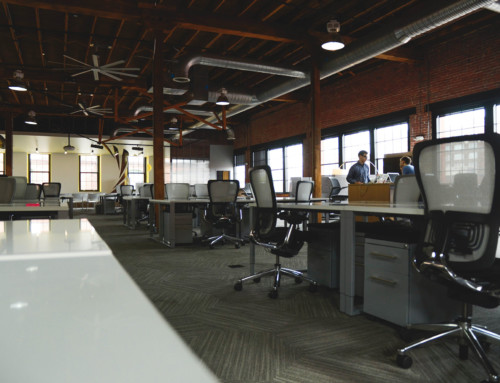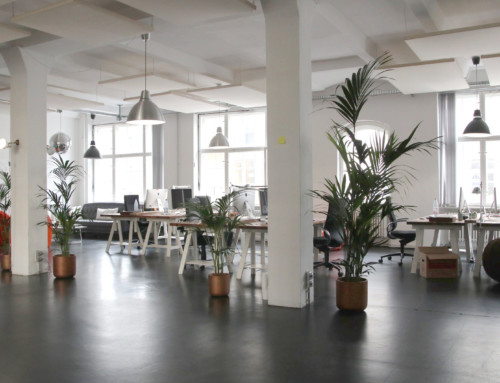We usually associate the word ergonomics with appliances like desks, chairs, keyboards, and other physical things that affect our posture, with brands that slap the words on alongside ‘lumbar support’ and ‘minimising muscle strain’. But an office space is more than that. A good office that’s taking an efficient and comforting work environment in mind also has to take into account the crucial factor of lighting.
We take in 85% of our information through sight, and in an office environment, we often spend most of our day straining our eyes against screens and paperwork. This constant visual demand is leading to more employees experiencing Computer Vision Syndrome (CVS), with symptoms that include:
- dry eyes,
- headaches,
- blurred vision,
- light sensitivity,
- pain in shoulders, neck and back,
- eyestrain, as well as pink or red eyes,
which good, conscious lighting choices can help prevent.
Poor lighting in the office—whether too dim or too bright—can lead to significant issues. Dim lighting often causes employees to squint, leading to eye strain, while overly bright lighting can wash out computer screens, making it harder to see clearly.
These poor lighting choices can cause employees to feel tired, stressed, and less productive, increasing the likelihood of errors and accidents. Choosing ergonomic lighting can make a meaningful difference, helping employees feel more comfortable, focused, and energised throughout the day.
Design your workspace to offer flexibility and lighting options that suit each employee’s needs. This approach not only boosts satisfaction but also allows you to cater to specific requirements—like adjusting lighting for tasks that switch between screen and paper or accommodating the needs of older employees. As eyesight naturally diminishes with age, older workers may require significantly more light to read the same documents as younger colleagues. Providing adaptable lighting supports comfort, productivity, and inclusivity in your workplace.
Check out these small ways you can make your office a better place to work, ergonomic lighting wise, so that everyone in your office can have a more productive, happier workplace.
Dual source ergonomic lighting
Dual source lighting is the implementation of using both overhead lighting, as well as task lighting. By having a global source of light while giving your workers the autonomy of something like desk lamps, you can help individualise your worker’s needs according to their station.
For example, many workers need to switch between using their computer monitor and paper documents. However, paper requires much higher lighting than a monitor. By a task light, your employee can switch their lighting accordingly, with their desk-lamps trained on their documents while relying on global lighting for their monitors, reducing eyestrain by having the optimal amount and source of light at all times.
Dual source lighting can also help lessen your environmental impact while saving on your financials. By reducing the need for excessive overhead lighting even when it’s unnecessary, having conscious workers may help save you electricity bills as well as have ergonomic lighting benefits.
Choosing a yellow toned light instead of white is better ergonomic lighting
Yellow toned lights are easier on the eyes, as they feel more natural than bright white lights like fluorescents. Not only do they mess with the circadian rhythms less, yellow-toned lights are also more psychologically pleasing.
Careful lighting placements leads to better ergonomic lighting
Modern offices rely heavily on computers, making it essential to manage screen glare effectively. Computer screens not only emit their own light but can also reflect light from other sources, creating glare that makes it harder for employees to focus. While glare shields and filters are available, they often reduce image clarity on the monitor. Creating a workspace that minimises glare from the start can help employees work comfortably without compromising screen quality.
Try using indirect lighting sources, where lighting design glares the light produced straight from the bulb onto other surfaces to use them as reflectors, letting the light to distribute evenly throughout the room. This type of lighting technique is categorised under ambient lighting, and is generally a gentler way of lighting your rooms.
If you can’t afford to switch your office design to indirect lighting, or there may be immovable bright lights in your office, then perhaps think of the placement of your office-tables. Avoid placing your worker’s screens where a bright light can directly bounce off them.
The same problem – but with windows
Position monitors so they don’t face windows to reduce the risk of glare, which can make it difficult for employees to see their screens clearly. If moving the screens isn’t possible, consider installing blinds that can be adjusted when sunlight becomes too bright. Alternatively, investing in window tints can help control brightness levels consistently, eliminating glare issues altogether and creating a more comfortable workspace.
There are other small ways that can help your employees, such as advising them to install apps like f.lux that automatically adjust the brightness of their screens throughout the day, or educating them on basic eye health exercises (basic things like telling them to look at something far away every half-hour or so to re-adjust their eyes). By doing so, you can protect them from wrecking too much havoc with their circadian rhythms that interrupt their sleep, and keep their health and wellbeing on the forefront your concerns.
Try considering ergonomic lighting in your workplace to encourage health, wellness and productivity.
If you have any questions about your next project or would like to discuss your existing office fitout, consider contacting us via our contact form or email us on info@sbprojects.com.au.



